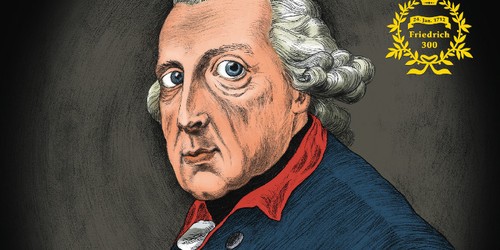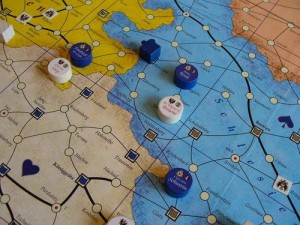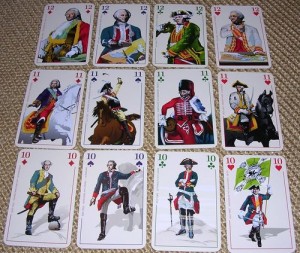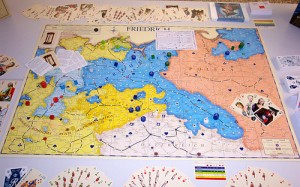By Fred Manzo
“I begin by taking. I shall find scholars later to demonstrate my perfect right”
Friedrich, a war game of the Seven Years War, is a design of elegance and of surprising depth. Although it is open to charges of having somewhat gamey mechanics as its pseudo-terrain and supply system revolves around the card suits assigned to each portion of a rather abstract point-to-point 1756 map of Europe. (There is little in the way of terrain on the board beyond the routes shown and the speed possible when moving from place to place).
One of my few criticisms of the design is that the card suit areas superimposed on the map are all square and they are all of the same size. Why use such an arbitrary element when designing these sectors in the first place? But that’s really a minor point. Though others have also complained of the down-time and the overall length of play, in my opinion while for a Euro it is indeed a LONG game, for those use to wargames its average. Basically, once you know the rules it can be played to conclusion in an evening. As for the down-time problem, well, decreasing the number of players should fix that.
For, while Friedrich can handle 5 or 6 players: the Prussians and their Hanoverian allies against the French, Swedes, Austrians and Russians Coalition, with competent play there really isn’t that much for some of the countries to do. For example, the Swedes. So I’d say it’s really a 3 or 4 player game, with three players possibly the best fit. The only other criticism I’ve heard of the game is that a country, and therefore the player controlling it, can be eliminated by random events, which is a real downer after you’ve put three or four hours into a game. But controlling a pair of countries should limit this problem also, which again leads to a three player game being ideal.
The heart of Friedrich’s innovative system, however, is that it allows players to augment the combat strength of their forces by playing cards of the correct suit: clubs, diamonds, spades or hearts. So, for example, if Friedrich the Great attacks in Poland with an 8 strength force against say a 6 strength Russian force, players may use only those cards in their hand that agree with the suit valid for that particular point. The winner and the size of the victory then is determined by the combined total of troop strengths involved and tactical cards played. This system has the advantage of generating additional supply problems and limited intelligence questions. For instance, did Friedrich stocked-pile enough of the correct card suit to attack properly? And even terrain problems, such as “will the defender be able to counter-attack from adjacent areas controlled by some other card suit and so run Friedrich out of his remaining supply of valid cards even if he initially wins?” Or “can the Coalition take advantage of Friedrich’s depleted hand to launch attacks in another part of Europe?”
Friedrich also enhances this Fog-of-War element by using hidden army rosters, so that while the location of any particular force may be known, its size is a matter of some conjecture (and memory).
By the way, the random events mentioned above are generated by a separate system, the “Cards of Fate,” with the killer event being the withdrawal of the Russian Empire from the war when the anti-Prussian Tsarina, Elisabeth is replaced by the very pro-Prussian Czar, Peter III, allowing Friedrich to snatch victory from the jaws of defeat. So although the Prussian position is a tough one, if Friedrich keeps cool, victory is possible.
Bottom line: Recommended.
 There is an updated on-line strategy guide at BoardgameGeek under the “Files” section of the Friedrich game that is quite useful and there is a follow up game named Maria, which uses a similar system.
There is an updated on-line strategy guide at BoardgameGeek under the “Files” section of the Friedrich game that is quite useful and there is a follow up game named Maria, which uses a similar system.
Games Resources
Friedrich Extended Example of Play and Players Aid













Great review that catches the main tensions and excitements of this game!
As for the criticisms you mentioned: Friedrich is explicitly designed for three or four players only (and works well with both player counts). The small countries Sweden, Hanover, and the Imperials are all aligned with a major power and not supposed to be played independently. While countries might be eliminated by cards of fate, players are not – say, Russia drops out by the death of the Tsarina, but the Russian player still controls Sweden. So everybody is involved until the very end of the game (albeit with possibly fewer forces under one’s control).
Still, the players have a different amount of things to do – France has often the shortest, Prussia/Hanover almost always the longest turns. But either can suit a player well depending on their mood for the game 🙂